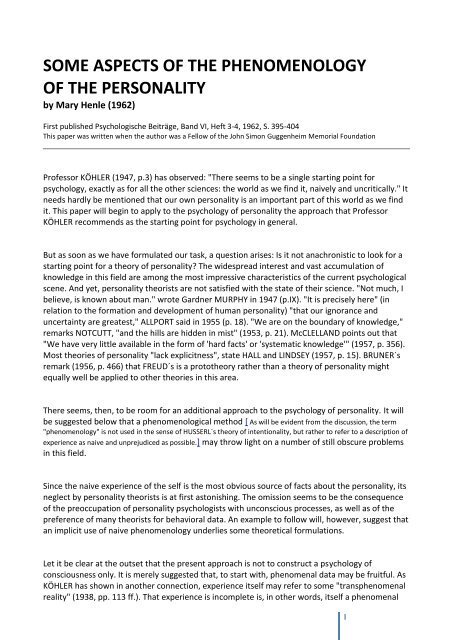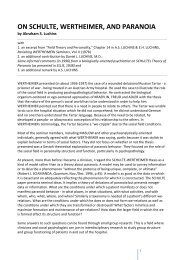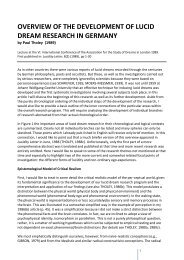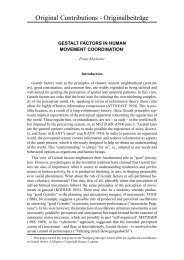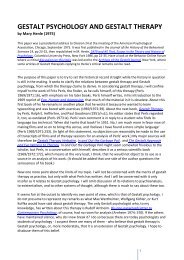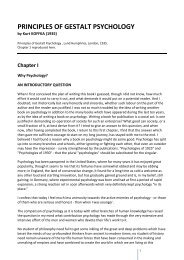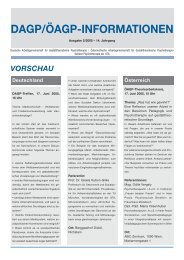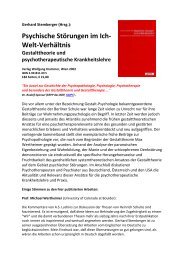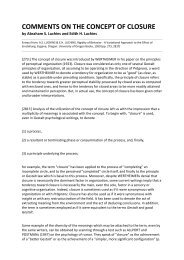pdf-Download - Society for Gestalt Theory and its Applications (GTA)
pdf-Download - Society for Gestalt Theory and its Applications (GTA)
pdf-Download - Society for Gestalt Theory and its Applications (GTA)
Create successful ePaper yourself
Turn your PDF publications into a flip-book with our unique Google optimized e-Paper software.
SOME ASPECTS OF THE PHENOMENOLOGY<br />
OF THE PERSONALITY<br />
by Mary Henle (1962)<br />
First published Psychologische Beiträge, B<strong>and</strong> VI, Heft 3-4, 1962, S. 395-404<br />
This paper was written when the author was a Fellow of the John Simon Guggenheim Memorial Foundation<br />
Professor KÖHLER (1947, p.3) has observed: "There seems to be a single starting point <strong>for</strong><br />
psychology, exactly as <strong>for</strong> all the other sciences: the world as we find it, naively <strong>and</strong> uncritically." It<br />
needs hardly be mentioned that our own personality is an important part of this world as we find<br />
it. This paper will begin to apply to the psychology of personality the approach that Professor<br />
KÖHLER recommends as the starting point <strong>for</strong> psychology in general.<br />
But as soon as we have <strong>for</strong>mulated our task, a question arises: Is it not anachronistic to look <strong>for</strong> a<br />
starting point <strong>for</strong> a theory of personality? The widespread interest <strong>and</strong> vast accumulation of<br />
knowledge in this field are among the most impressive characteristics of the current psychological<br />
scene. And yet, personality theorists are not satisfied with the state of their science. "Not much, I<br />
believe, is known about man." wrote Gardner MURPHY in 1947 (p.IX). "It is precisely here" (in<br />
relation to the <strong>for</strong>mation <strong>and</strong> development of human personality) "that our ignorance <strong>and</strong><br />
uncertainty are greatest," ALLPORT said in 1955 (p. 18). "We are on the boundary of knowledge,"<br />
remarks NOTCUTT, "<strong>and</strong> the hills are hidden in mist" (1953, p. 21). McCLELLAND points out that<br />
"We have very little available in the <strong>for</strong>m of 'hard facts' or 'systematic knowledge'" (1957, p. 356).<br />
Most theories of personality "lack explicitness", state HALL <strong>and</strong> LINDSEY (1957, p. 15). BRUNER´s<br />
remark (1956, p. 466) that FREUD´s is a prototheory rather than a theory of personality might<br />
equally well be applied to other theories in this area.<br />
There seems, then, to be room <strong>for</strong> an additional approach to the psychology of personality. It will<br />
be suggested below that a phenomenological method [ As will be evident from the discussion, the term<br />
"phenomenology" is not used in the sense of HUSSERL´s theory of intentionality, but rather to refer to a description of<br />
experience as naive <strong>and</strong> unprejudiced as possible.] may throw light on a number of still obscure problems<br />
in this field.<br />
Since the naive experience of the self is the most obvious source of facts about the personality, <strong>its</strong><br />
neglect by personality theorists is at first astonishing. The omission seems to be the consequence<br />
of the preoccupation of personality psychologists with unconscious processes, as well as of the<br />
preference of many theorists <strong>for</strong> behavioral data. An example to follow will, however, suggest that<br />
an implicit use of naive phenomenology underlies some theoretical <strong>for</strong>mulations.<br />
Let it be clear at the outset that the present approach is not to construct a psychology of<br />
consciousness only. It is merely suggested that, to start with, phenomenal data may be fruitful. As<br />
KÖHLER has shown in another connection, experience <strong>its</strong>elf may refer to some "transphenomenal<br />
reality" (1938, pp. 113 ff.). That experience is incomplete is, in other words, <strong>its</strong>elf a phenomenal<br />
1
datum. A psychology of personality must encompass not only the phenomena, the facts of<br />
behavior <strong>and</strong> experience, but also the functional relations which are responsible <strong>for</strong> their<br />
occurrence <strong>and</strong> nature. These, to a large extent, transcend phenomonology.<br />
It must also be understood that the purpose of this paper is not to make final <strong>and</strong> definitive<br />
statements about the experience of the self, but rather to explore an approach. The difficulties of<br />
naive phenomenal description are well known. The ef<strong>for</strong>ts of any one investigator need to be<br />
tested by others; <strong>and</strong> the statements about the phenemenology of the personality to be made<br />
below might perhaps best be regarded as hypotheses. And many problems remain that cannot be<br />
treated here: <strong>for</strong> example, the question of how far it is useful to carry the analysis to be begun<br />
here; or that of the conditions <strong>and</strong> criteria <strong>for</strong> checking such phenomenal descriptions.<br />
The most obvious fact about the self as we experience it is the multiplicity of aspects it presents.<br />
We do not ordinarily appear to ourselves as an undifferentiated "I".<br />
The experienced differentation of the self is implicit in a remark that PLATO, in the Sophist, puts in<br />
the mouth of the Stranger: "Is not thought the same as speech, with this exception: thought is the<br />
unuttered conversation of the soul with herself?" (JOWETT trans., vol. 3, p. 504). MONTAIGNE<br />
likewise observes that "we have a soul that can turn upon <strong>its</strong>elf, that can keep company with <strong>its</strong>elf;<br />
it has the wherewithal to attack <strong>and</strong> defend, to receive <strong>and</strong> give..." (TRECHMANN trans., vol.1, p.<br />
238). A more recent illustration is attributed to George Bernard SHAW: "On one occasion, when in<br />
debate a critic had said, "Mr. Shaw, you seem to talk like two people", Shaw answered, "Why only<br />
two?" (WALLAS, 1926, p. 164). Once more, HESSE remarks:<br />
When Faust ... says: "Two souls, alas, inhabit in my breast!" he has <strong>for</strong>gotten Mephisto <strong>and</strong> a whole crowd of other<br />
souls that he has in his breast likewise. The Steppenwolf, too, believes that he bears two souls (wolf <strong>and</strong> man) in his<br />
breast <strong>and</strong> even so finds his breast disagreeably cramped because of them. The breast <strong>and</strong> the body are indeed one,<br />
but the souls that dwell in it are not two, nor five, but countless in number (1957, p. 81).<br />
It is unnecessary to multiply examples, since the reader can easily confirm <strong>for</strong> himself the<br />
experienced multiplicity of the self (or usually, as will be indicated below, the experienced duality<br />
of the personality at any given moment). It is more important to begin to identify the aspects of<br />
oneself that present themselves <strong>for</strong> observation. What are the various meanings of the "I"? A<br />
simple method enables us to approach our problem. We may start with a number of<br />
commonplace sentences in which "I" or "me" is used:<br />
"I think I dialed the wrong number."<br />
"I blame myself <strong>for</strong> what happened."<br />
"I don´t know what got into me."<br />
"I didn´t let on how I was really feeling."<br />
"I´ll give myself ten minutes to get out of bed."<br />
"That´s an idea of mine I don´t take particularly seriously."<br />
2
"I wonder if I´m doing the right thing."<br />
"I was lost in thought."<br />
Even a hasty consideration of these sentences suggest that the repeated "I" does not refer to the<br />
same thing. It seems that even when we confine ourselves to what is phenomenally present, the<br />
self consists of a variety of functions. Let us begin to enumerate them. Although we often tend to<br />
personify them, actually they are functions, not entities.<br />
Let us start with a very simple example: "I think I dialed the wrong number." The one "I" is clearly<br />
st<strong>and</strong>ing off <strong>and</strong> observing the other. The observing I is not entering into the action in this case,<br />
but simply watching it. We distinguish here between the observer <strong>and</strong> the actor.<br />
One of the observer of this observer was THOREAU. He writes:<br />
With thinking we may be beside ourselves in a sane sense ... I ... am sensible of a certain doubleness by which I can<br />
st<strong>and</strong> as remote from myself as from another. However intense my experience, I am conscious of the presence <strong>and</strong><br />
criticism of a part of me, which, as it were, is not a part of me, but a spectator, sharing no experience, but taking note<br />
of it, <strong>and</strong> that is no more I than it is you. When the play, it may be the tragedy, of life is over, the spectator goes his<br />
way. It was a kind of fiction, a work of the imagination only, so far as he was concerned. This doubleness may easily<br />
make us poor neighbors <strong>and</strong> friends sometimes (1950 ed., p. 122).<br />
The observer may st<strong>and</strong> in any relation to the actor, from relative detachment to considerable<br />
involvement - precisely as we may relate to a work of fiction. Thus we say: "I watched myself as if<br />
it were a dream," or "as if it were somebody else." Or on the other h<strong>and</strong>, "I saw with dismay that I<br />
was doing so-<strong>and</strong>-so." Sometimes the actor steals the show during the action, <strong>and</strong> allows scope <strong>for</strong><br />
the observer only afterwards, when we have the illuminating hindsight. In other cases it is the<br />
observer who takes over, paralyzing action <strong>and</strong> preventing the outward turning of interest, as<br />
THOREAU hints.<br />
Closely allied to the observing aspect of the person is a critical one. While our observations of<br />
ourselves may be objective, non-evaluative <strong>and</strong> dispassionate, they are more likely to contain a<br />
critical note. T.S. ELIOT, in 'The Elder Statesman' (1959, p. 44), has Lord Claverton ask:<br />
What is this self inside us, this silent observer,<br />
Severe <strong>and</strong> speechless critic, who can terrorize us<br />
And urge us on to futile activity,<br />
And in the end, judge us still more severely<br />
For the errors into which his own reproaches drove us?<br />
In the course of observing <strong>and</strong> criticizing, we either accept or reject what we find in ourselves. "We<br />
3
all have flaws," said the Duke, "<strong>and</strong> mine is being wicked" (THURBER, 1950, p. 114). Being human,<br />
he knows himself to be imperfect, but he can accept himself with his "flaw". On the other h<strong>and</strong>,<br />
we may reject, saying: "That wasn´t like me," "I can´t underst<strong>and</strong> how I could say such a thing,"<br />
"I´m not myself today."<br />
Do we need to postulate additional functional variables with their phenomenal counterparts to<br />
account <strong>for</strong> such experiences? It may be that the rejection of aspects of the self is a function of the<br />
critic, while in acts of self-acceptance we get a first glimpse of the inner friend, who will be<br />
discussed below.<br />
We may pause <strong>for</strong> a moment <strong>and</strong> consider that, without going beyond phenomenal experience,<br />
we have distinguished several functions of the self in addition to the actor: the observer, the critic,<br />
the friend, <strong>and</strong> possibly a functionally distinct rejecting aspect. These functions have already been<br />
brought to our attention in FREUD´s concept of the super-ego. Our discussion suggests the<br />
considerable extent to which FREUD must have relied on phenomenal evidence in arriving at this<br />
concept. A quotation will confirm the impression that the super-ego is more a phenomenal report<br />
than a psychological theory:<br />
One group of [psychotics] suffer what we call delusions of observation. They complain to us that they suffer<br />
continually, <strong>and</strong> in their most intimate actions, from the observation of unknown powers or persons, <strong>and</strong> they have<br />
hallucinations in which they hear these persons announcing the results of their observations: 'now he is going to say<br />
this, now he is dressing himself to go out,' <strong>and</strong> so on. Such observation is not the same thing as persecution, but it is<br />
not far removed from it. It implies that these persons distrust the patient, <strong>and</strong> expect to catch him doing something<br />
that is <strong>for</strong>bidden <strong>and</strong> <strong>for</strong> which he will be punished. How would it be if these mad people were right, if we all of us had<br />
an observing function in our egos threatening us with punishment, which, in their case, had merely become sharply<br />
seperated from the ego <strong>and</strong> had been mistakenly projected into external reality? (1933, p. 85).<br />
So far, then, we have not gone much beyond FREUD´s phenomenal observations. And yet there<br />
are certain advantages to our more modest procedure. The functions mentioned above are<br />
separate, thought relates functions; this is clear since they may appear separately - the observer<br />
without the critic, etc. If we throw them all into a super-ego, it is more difficult to distinguish<br />
them. There may, indeed, be antagonisms among them, <strong>for</strong> example between the observer <strong>and</strong><br />
the rejecting function; these are lost if we speak only of the antagonisms between the super-ego<br />
<strong>and</strong> other parts of the person. FREUD´s super-ego neglects the positive accepting function. And<br />
most important, if we deal with the problem in the manner suggested here, it is much easier to<br />
see these functions <strong>for</strong> what they are, namely phenomenally present functions, not as<br />
hypothetical agencies of the mind.<br />
To return to the inner friend, this function is phenomenally present whenever we find in ourselves<br />
a source of com<strong>for</strong>t or encouragement. Coming to a new underst<strong>and</strong>ing or reaching a decision is<br />
often preceded by real discussion within the self - an "inner dialogue", as JUNG calls it (e.g., 1960,<br />
p. 89). The gift to oneself likewise refers to the inner friend, since giving implies a duality, a donor<br />
<strong>and</strong> recipient, "a soul that ... has the wherewithal ... to receive <strong>and</strong> give," in MONTAIGNE´s word.<br />
(Cf. JUNG on the friend, e.g., 1959, p. 133).<br />
But the most significant of the inner friend has been mentioned above, that of self-acceptance.<br />
4
Although it is not possible here to discuss this problem, <strong>its</strong> importance may be referred to by way<br />
of a remark of JUNG´s: "Acceptance of oneself is the essence of the moral problem <strong>and</strong> the acid<br />
test of one´s whole outlook on life" (1958, p. 339).<br />
Phenomenally distinct from the aspects of the personality so far mentioned are various impulsive<br />
functions. We say: "I don´t know what made me do it," or "I don´t know what got into me." It is<br />
the observer or critic who raises the question, while the actor appears as the tool of an often<br />
unknown, but phenomenally important, impulse. Or else, the impulse may be clearly recognized,<br />
but still experientially distinct from the doer, <strong>for</strong> example the "irresistible impulse." It might be<br />
thought that we are now discussing the Freudian id. But it must be remembered that the id is<br />
unconscious, while we are dealing here with facts of conscious experience, facts which may, but<br />
need not, refer to transphenomenal data.<br />
Another aspect of the experienced self is the facade, the front we present to the world. We say: "I<br />
could see I was making a bad impression." The critic is here not criticizing the innermost self, but<br />
rather the impression the self makes. The facade is what JUNG calls the persona (e.g., 1953, pp.<br />
154ff.), again a phenomenal fact. We say somebody that he is a stuffed shirt, <strong>and</strong> we mean he is all<br />
facade with little of interest beneath. Facades present as great a variety as people do. Sometimes<br />
there is a considerable contrast between the real person <strong>and</strong> the front he presents, so that we<br />
occasionally have surprises when a person´s situation changes. On the whole, though, the persona<br />
is an expression of the person himself; <strong>and</strong> like other expressions, it is characteristic of him. Like<br />
our clothes, the persona serves the functions of protection <strong>and</strong> adornment.<br />
We see another dimension of the phenomenal self in the following example: "That´s an idea of<br />
mine I don´t take particularly seriously." Here we see the realist in conflict with the dreamer. Some<br />
of us have a more developed dreamer than realist, while with others the realist carries more<br />
weight. For example MINNIVER, who curses the commonplace, is letting his dreamer crowd out<br />
the realist. On the other h<strong>and</strong>, THURBER´s man who "doesn´t know anything but facts" might well<br />
allow more scope to his dreamer. The dreamer says: "I think I´ll take a trip around the world," <strong>and</strong><br />
the realist retorts: "Fine. And what will you use <strong>for</strong> money?"<br />
Space does not permit a continuation of this analysis, though we have by no means exhausted the<br />
phenomenally distinguishable aspects of the personality. I will only add that, although conflicts are<br />
experiences, as in some of the examples given above, these experientially distinct aspects of the<br />
self work together, on the whole, in an organized manner, with reference to each other if not<br />
always in harmony. Furthermore, they are not all experienced together. Ordinarily, it seems, we<br />
divide ourselves phenomenally into two or possible three at any given moment. The paradigm is<br />
the dialogue, not the mob scene.<br />
It has been indicated above that an adequate psychology of personality cannot be limited to a<br />
psychology of consciousness. Of what use, then, is this kind of phenomenological study? First of<br />
all, this is an important source of facts about the personality, most of which have been neglected<br />
by current theories. In addition, several problems will be mentioned, to whose solution this kind of<br />
material might contribute.<br />
1. As mentioned above, conscious experience <strong>its</strong>elf points to a realm of existence that is not<br />
conscious (cf. KÖHLER, 1938). Whatever their disagreements, most psychologists of<br />
5
personality are agreed on a role of unconscious processes in the determination of behavior<br />
<strong>and</strong> experience. But unconscious processes, by definition, cannot be known. Whatever<br />
their nature, however, a great deal of evidence suggests that they can find expression only<br />
in behavior or by way of conscious processes; <strong>and</strong> other kinds of cooperation between<br />
conscious <strong>and</strong> unconscious processes - ways of working with mutual reference to each<br />
other - also seem indicated. In the light of such considerations, it is a plausible hypothesis<br />
that conscious functions have their unconscious counterparts. Thus any useful new<br />
categories on the side of consciousness might yield avenues of approach to corresponding<br />
unconscious processes.<br />
2. Another possible application of this phenomenological approach is to the psychology of<br />
interpersonal relations. As a starting hypothesis, it is suggested that the phenomenally<br />
present inner figures here described may give us a clue to the kind of person an individual<br />
seeks <strong>and</strong> the kind of person he is able to relate to outside himself. Thus we may seek the<br />
outer friend - or many outer friends - in place of the inner friend who is not sufficiently<br />
developed. Of course outer friends are essential, but they cannot replace the inner friend.<br />
In fact, without some development of the inner friend, it seems that we cannot relate to<br />
the outer one. If we do not like ourselves enough, we will not believe that the other likes<br />
us; if we do not accept ourselves enough, we will not let the other accept us.<br />
To take another example, the dreamer may seek his realist outside. Don Quixote had his<br />
Sancho Panza. But unless he has the experience of an inner realist, he will probably not be<br />
able to put up with the outer realist´s lack of imagination, his soberness, his concern <strong>for</strong><br />
pedestrian realities. And the realist who has not developed his inner dreamer may search<br />
<strong>for</strong> an outer one; but when he finds him he will be distressed by his flights of fancy, his<br />
impracticality, his inability to keep his feet on the ground or to look where he is going.<br />
Again, our relations with the outer critic depend to a large extent on the development of<br />
the inner one. If our inner critic is fair, objective <strong>and</strong> judicious, we will be able to accept<br />
outer criticism when it is warranted <strong>and</strong> objective, <strong>and</strong> profit from it. If the inner critic is<br />
harsh, unfair <strong>and</strong> without humanity, we will experience outer criticism also as attack, <strong>and</strong><br />
we will run from it or counterattack. If our inner critic is undeveloped, so that we have not<br />
had the experience of good inner criticism, the chances are that we will be able to use little<br />
of the criticism we are offered so freely from outside. Then criticism is likely to be met with<br />
exaggerated resentment, <strong>and</strong> unwarranted criticism is likely to be attributed to hostility<br />
rather than to error.<br />
It is perhaps unnecessary to add that the nature <strong>and</strong> development of our inner critic is<br />
importmant not only <strong>for</strong> how we take criticism, but also <strong>for</strong> how we give it to others. [Of<br />
course in all these cases we are dealing with a circular process. Not only do our relations with outer friends,<br />
outer critics, etc. depend upon the state of the corresponding inner functions; the development of the inner<br />
friend depends on significant outer relations, that of the inner critic depends on our experience with criticism<br />
offered from the outside, etc. Since developmental problems have not been discussed here, only the <strong>for</strong>mer<br />
set of relations has been considered.]<br />
It was mentioned earlier that we often tend to personify the phenomenologically distinct<br />
functions of the self. The present discussion illustrates one sense in which we literally do<br />
this: the tendency so seek in other persons those functions insufficiently developed in us.<br />
But it has also been suggested that our relations with the individuals who personify these<br />
functions depend on our own inner development.<br />
3. To continue with the uses of the present approach: developmental problems, as well as<br />
new approaches to individual differences, suggest themselves as a consequence of our<br />
phenomenological approach.<br />
6
4. The present approach suggests a partial answer to the question of how it is possible to<br />
know oneself. When we become acquainted with any outside object, we st<strong>and</strong> apart from<br />
it <strong>and</strong> are thus enabled to examine it. In the case of knowing ourselves this essential<br />
condition of objectivity - the differentiation of subject <strong>and</strong> object, of knower <strong>and</strong> known -<br />
appears to be absent. [There are other difficulties in knowing oneself that are not relevant in the present<br />
connection] But if the self is not only single, but also dual or even triple at any given time,<br />
there is indeed a differentiation of knower <strong>and</strong> known, <strong>and</strong> we have the possibility of<br />
st<strong>and</strong>ing apart <strong>and</strong> observing. Knowing the self can now be seen to have something in<br />
common with knowing another person. It is not the actor who knows himself, but the<br />
observer who knows the actor, the realist who knows the dreamer or the actor, etc.<br />
Corresponding to the various divisions within the person, we come to have a number of views of<br />
ourselves. For example, the views of the inner friend <strong>and</strong> the critic are likely to be different.<br />
This divergence of opinion provides the possibility of a more balanced view of ourselves. Or, if we<br />
are less <strong>for</strong>tunate, one such partial view may become the dominant one. Or else,<br />
compartmentalization may occur: the dreamer is allowed his freedom, <strong>for</strong> example, so long as he<br />
keeps out of the actor´s way.<br />
This paper has dealt in a preliminary way with only a single problem in the phenomenology of the<br />
personality, namely that of the experienced multiplicity of the self. Many additional problems<br />
remain to be studied. Some attention has been given to the matter of ego boundaries, the<br />
question of how much of the phenomenal world is experienced as "I" <strong>and</strong> how much as "not-I".<br />
The boundaries of the "you" or the "he" present equally interesting problems. Many aspects of the<br />
phenomenology of motivation <strong>and</strong> of the emotions likewise suggest themselves as ripe <strong>for</strong> study.<br />
Summary<br />
This paper has dealt with a problem in the phenomenology of the personality, namely that of the<br />
experienced multiplicity of the self. We do not experience ourselves as a single undifferentiated<br />
"I"; rather, a number of distinguishable functions are phenomenally present. Several of these were<br />
discussed briefly; the actor, observer, critic, friend, impulsive functions, facade, dreamer <strong>and</strong><br />
realist. These act with reference to each other, even if not always in harmony, <strong>and</strong> ordinarily no<br />
more than two or possible three such aspects of the self are experienced at any given moment. In<br />
addition to calling attention to a neglected body of data about the personality, this approach<br />
seems to clarify a number of problems in the psychology of personality.<br />
References<br />
ALLPORT, G.W.: Becoming. New Haven: Yale Univer.Press, 1955.<br />
BRUNER, J.S.: Freud <strong>and</strong> the image of man. Amer.Psychologist, 1956, 11, 463-466.<br />
ELIOT, T.S.: The elder statesman, London: Faber & Faber, 1959.<br />
FREUD, S.: New introductory lectures on psycho-analysis. Tr. by W.J.H. Sprott. New York: Norton, 1933.<br />
HALL, C.S. & G. LINDZEY: Theories of personality. New York: Wiley, 1957.<br />
7
HESSE, H.: Steppenwolf. Tr. by B. Creighton. New York: Ungar, 1957.<br />
JUNG, C.G.: Two essays on analytical psychology. Tr. by R.F.C. Hull. Bollingen Series XX. New York: Pantheson, 1953.<br />
JUNG, C.G.: Psychology <strong>and</strong> religion: West <strong>and</strong> East. Tr. by R.F.C. Hull. Bollingen Series XX. New York: Pantheson, 1958.<br />
JUNG, C.G.: The structure <strong>and</strong> dynamics of the psyche. Tr. by R.F.C. Hull. Bollingen Series XX. New York: Pantheson,<br />
1960.<br />
KÖHLER, W.: The place of value in a world of facts. New York: Liveright, 1938.<br />
KÖHLER, W.: <strong>Gestalt</strong> psychology (rev.ed.). New York: Liveright, 1947.<br />
Mc CLELLAND, D.C.: Toward a science of personality psychology. in: H.P. David <strong>and</strong> H.v. Bracken (Eds.). Perspectives in<br />
personality theory. New York: Basic Books, 1957.<br />
MONTAIGNE, M. de: Essays. Tr. by. E. J. Trechmann. New York: Ox<strong>for</strong>d Univ. Press. n.d.<br />
MURPHY, G.: Personality. New York: Harper, 1947.<br />
NOTCUTT, B.: The psychology of personality. London: Methuen, 1953.<br />
PLATO, Dialogues. Tr. by. B. Jowett, New York: Scribner´s, 1982.<br />
THOREAU, H.D.: Walden. New York: Modern Library, 1950.<br />
THURBER, J.: The 13 clocks. New York: Simon <strong>and</strong> Schuster, 1950.<br />
WALLAS, G.: The art of thought. New York: Harcourt Brace, 1926.<br />
8


